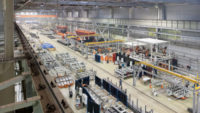How effective is UV-C for industrial hygiene?

Workplace hygiene has always been part of maintaining a commercial facility regardless of the industry. However, the COVID-19 pandemic brought the need for advanced disinfection techniques into sharp relief.
UV-C disinfection is a popular choice for hospitals and other medical facilities, but how effective is it for industrial hygiene?
Variations of UV radiation
UV — or ultraviolet — radiation exists on a wavelength visible to the unaided eye. Scientists break this radiation into three primary types — UV-A, UV-B and UV-C. The sun emits all three wavelengths of UV radiation, though UV-A and UV-B are the only ones that reach the surface. The atmosphere and ozone layer typically absorb UV-C.
UV-A and UV-B exposure are necessary to help the human body produce vitamin D, but excessive exposure can lead to sunburn and premature aging in the short term. It can also increase an individual’s risk of developing skin cancers such as melanoma.
While UV-C might not make it through the atmosphere, it is possible to replicate this ultraviolet wavelength and use it here on Earth.
How effective is UV-C?
Researchers classify UV-C radiation as germicidal. They may also refer to it as ultraviolet germicidal irradiation or UVGI. Exposure to this wavelength of light works to deactivate the DNA in any microorganisms it encounters, including but not limited to — bacteria, viruses and mold spores.
UV disinfection is a popular choice for destroying microorganisms in drinking water, making wastewater treatment safer, improving food safety and even promoting plant growth. During the COVID-19 pandemic, many building owners explored the potential for UV-C lamps in HVAC systems to kill airborne pathogens like COVID-19.
Research shows these lamps have the potential to inactivate or kill up to 98% of airborne pathogens within just five minutes of exposure. While COVID itself was not airborne, it could travel through HVAC systems on respiratory particles.
Risks of UV-C exposure
HVAC units and ductwork also employ UV-C disinfection techniques inside their systems. Building designers can also install it in upper air systems where people won’t be exposed to UV-C light.
This wavelength of light can degrade some materials over time. While exposure risks drop off around one foot from the light source, long-term exposure can cause various damages to human tissues. Research found direct exposure to UV-C light can cause corneal eye injuries and severe acute skin damage.
To minimize exposure, working in areas utilizing UV-C light for disinfection requires personal protective equipment (PPE), including UV goggles or face shields and attire covering all exposed skin. If decision-makers hope to implement UV-C in their facilities, they will have to require the proper PPE and safety training to reduce the risk of damage.
Using UV-C for industrial hygiene
Industrial hygiene focuses on identifying and eliminating or controlling workplace stressors and risks potentially impacting the well-being of workers. UV-C can be a valuable tool for companies with teams working in close proximity. It can work in building HVAC systems and could also double as a tool for disinfecting common surfaces such as tabletops or doorknobs.
This disinfection technique became vital throughout the COVID-19 pandemic and could help to prevent the spread of other viruses beginning to spread globally, such as monkeypox.
Monkeypox can spread through direct contact with an infected individual or contact with surfaces the individual has touched. CDC guidance states orthopoxviruses — such as monkeypox — are very sensitive to UV light, so UV-C disinfection could help prevent the virus from spreading within the workplace.
Experts also warn climate change could spark a new type of pandemic fueled by an infectious fungus. Current infrastructure is unprepared to handle this kind of pandemic, but UV-C light could help destroy the fungal spores in interior spaces, preventing the spread.
UV-C can also help improve interior air quality by destroying bacteria and viruses and nullifying mold, mildew spores and other organic airborne contaminants. It has no impact on inorganic contaminants, such as carbon monoxide and other common pollutants, but it can remove many organic problems from a building’s HVAC system.
Looking forward
The larger the team and the closer together they work, the more likely an infection will be able to spread quickly between them. Introducing tools like UV-C can help improve industrial hygiene and keep employees safe and healthy in the long run.
Looking for a reprint of this article?
From high-res PDFs to custom plaques, order your copy today!








